How to Request a Driving Record in Texas: A Comprehensive Guide
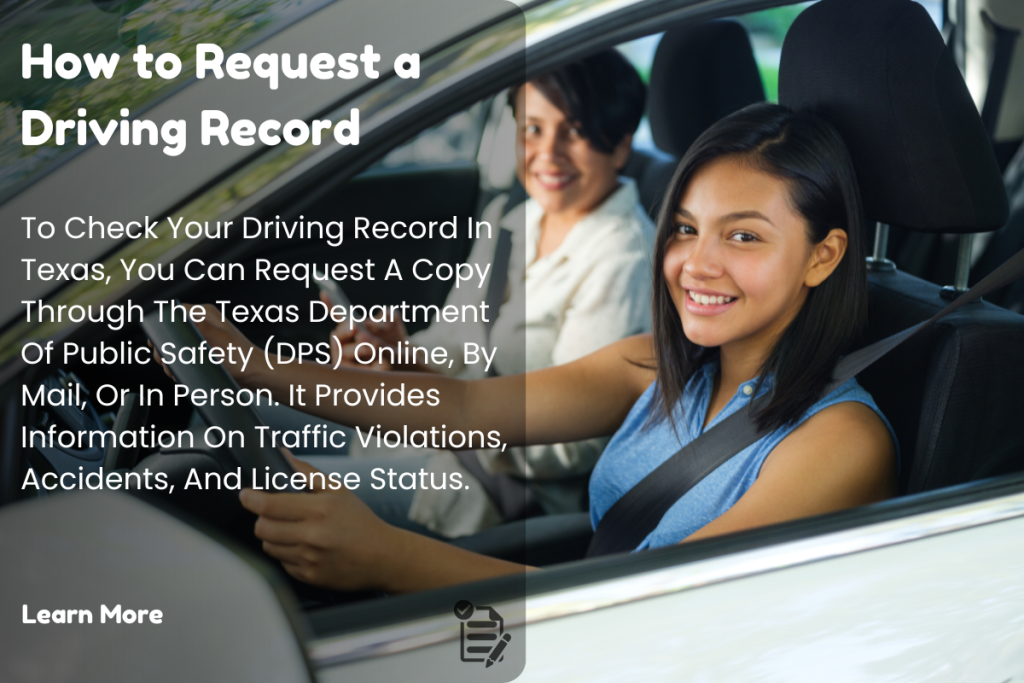
How to Check Driving Record in Texas: A Complete Guide
A driving record is an official document that outlines an individual’s driving history. In Texas, this document provides a comprehensive summary of your driving behavior, including key details such as traffic violations, accidents, license suspensions, and other relevant information. It’s maintained by the Texas Department of Public Safety (DPS) and serves as an important tool for various purposes.
Your driving record will typically contain the following information:
- Traffic Violations: Any moving violations like speeding tickets, running red lights, or other infractions.
- Accidents: Information about any accidents you’ve been involved in, including your role in the incident and whether or not you were at fault.
- License Suspensions or Revocations: If your license has been suspended or revoked due to any reason, it will be recorded here.
- Points on Your License: Texas operates on a point system, and your driving record will include any points added for violations.
- DUI or DWI Convictions: If you have been convicted of driving under the influence of alcohol or drugs, it will appear on your driving record.
Employers, insurance companies, law enforcement agencies, and even some potential landlords may request your driving record to assess your driving history. Whether you’re applying for a new job, purchasing auto insurance, or simply ensuring that your record is accurate, understanding how to check your driving record in Texas is crucial.
Why Should You Check Your Driving Record?
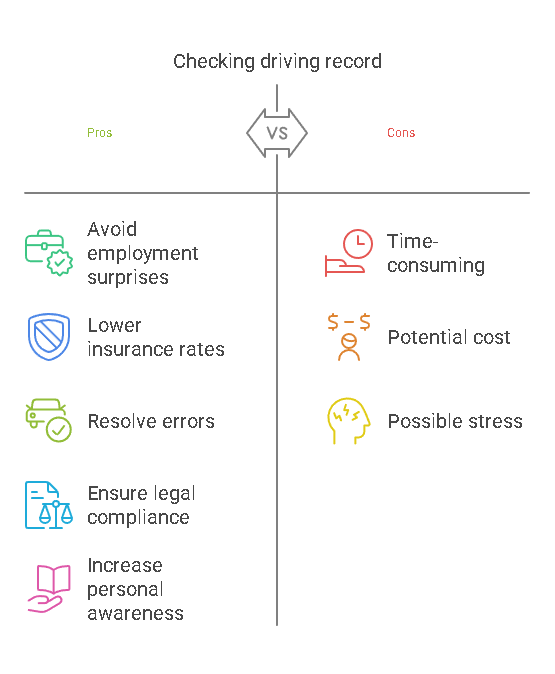
Checking your driving record is important for several reasons. Regularly reviewing your record helps ensure that the information it contains is accurate, which can save you from potential problems down the line. Here’s why it’s a good idea to check it periodically:
- Avoiding Surprises in Employment: Employers may review your driving record when considering you for a job, especially if the position involves driving. For example, companies that hire truck drivers, delivery drivers, or anyone who operates a company vehicle will often conduct driving record checks to ensure that applicants have a clean driving history.
- Lowering Auto Insurance Rates: Insurance companies use your driving record to assess risk and determine your premium rates. A clean record often results in lower insurance premiums. If your record has errors or outdated information, it could unfairly raise your rates.
- Resolving Errors: Sometimes, mistakes happen. You may have been incorrectly cited for a violation or a ticket may have been recorded on your record even after it was paid. Checking your driving record helps you catch these errors and ensure they are corrected before they affect your life.
- Legal Compliance: If you’ve been involved in legal matters, such as a DUI or traffic violation case, your driving record may be reviewed. Ensuring that all the information is accurate is crucial for resolving any disputes or potential legal consequences.
- Better Personal Awareness: By regularly checking your driving record, you can stay aware of your driving history, helping you be more mindful of your behavior on the road. If you’re unaware of accumulating points or violations, you may be risking your driving privileges or facing increased penalties.
How Often Should You Check Your Driving Record in Texas?
The frequency with which you should check your driving record can vary depending on your circumstances. For most drivers, it’s a good idea to check your record at least once a year. However, here are some specific scenarios where checking your record might be necessary:
- After Receiving a Traffic Ticket: If you’ve received a ticket for a traffic violation, especially a moving violation, it’s important to check your record after the fine is paid to ensure the ticket is properly cleared and the points are accurately reflected.
- Before Applying for a Job: If you’re applying for a job that requires driving, it’s wise to check your record in advance to make sure there are no surprises.
- If You’ve Been Involved in an Accident: After being in an accident, you should check your record to see if the incident has been properly documented. This ensures that any mistakes or inaccuracies are caught early on.
- If You’re Facing Legal Issues: If you’re involved in any legal cases, such as a DUI, it’s essential to review your record to ensure everything is documented correctly and that you are fully informed of your legal standing.
- Before Renewing Your License: Before you renew your Texas driver’s license, it’s good practice to review your driving record to ensure everything is up to date.
The Texas Department of Public Safety (DPS) maintains your driving record, and the agency provides access to this information online. This gives you the convenience of checking it at any time.
Overview of the Process of Checking a Driving Record in Texas
There are a few different methods for checking your driving record in Texas, and each comes with its own advantages and limitations. The process is simple, but understanding your options will ensure that you choose the right method based on your needs.
Method 1: Online via the Texas DPS Website
The Texas Department of Public Safety offers a streamlined online service that allows you to request and view your driving record instantly. This method is the fastest and most convenient way to access your driving history.
To access your driving record online, you will need:
- Your Texas driver’s license number.
- Your date of birth.
- A valid email address.
- A payment method for the $12 fee (for the standard 3-year or 7-year driving record).
The website is user-friendly and guides you through the steps. Once payment is made, you will typically receive your driving record in just a few minutes. In some cases, it may take a few days for the report to be processed.
Method 2: Requesting a Driving Record by Mail
If you prefer to request your record by mail, you can download the necessary forms from the Texas DPS website. You’ll need to fill out the form, provide payment (usually in the form of a check or money order), and mail it to the DPS. This process can take anywhere from 7 to 10 business days, depending on the volume of requests and processing times.
The advantage of requesting by mail is that it’s an option for individuals who may not have access to the internet, but it’s not as fast as the online process.
Method 3: Using Third-Party Services
If you need to check multiple driving records at once or are a business owner seeking driving records for employees or job applicants, third-party services can provide a quicker and more efficient solution. These services, such as Precisehire, streamline the process by offering bulk reports or background check services that can include driving records.
While third-party services may charge a higher fee than DPS directly, they can be more convenient for businesses or individuals with ongoing needs. They also provide additional features like automated report generation and compliance assistance.
In summary, checking your driving record in Texas is a straightforward process. Whether you use the DPS website, request it by mail, or choose a third-party service, you can easily gain access to your driving history whenever necessary.
How to Check Your Driving Record in Texas
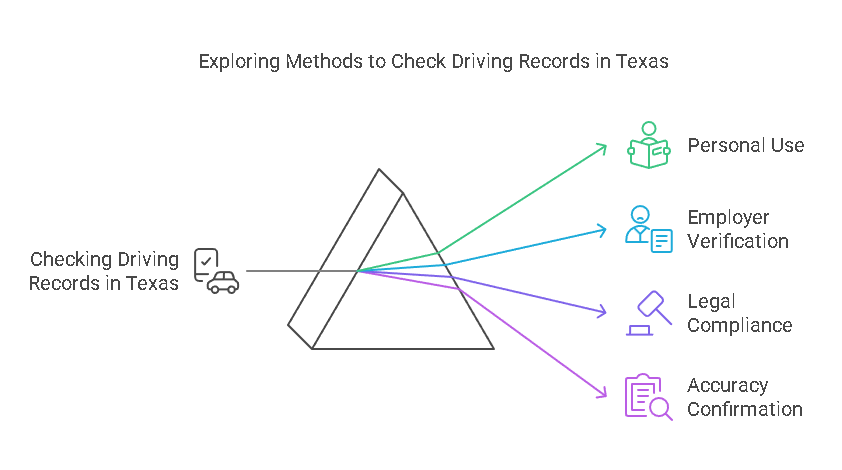
Checking your driving record is an essential task that drivers in Texas need to perform for various reasons, including ensuring that the information is accurate, understanding your driving history, or complying with legal or professional requirements. Whether you need to review your record for personal use or you are an employer seeking to verify the driving history of an employee or candidate, understanding the different methods for obtaining this information can save you time and effort.
Method 1: Checking Your Driving Record Online via Texas DPS
The Texas Department of Public Safety (DPS) offers the most convenient and widely used method for checking your driving record. This method is simple, secure, and typically provides immediate results or access to your driving record within a few days.
Step-by-Step Guide to Accessing Your Driving Record Online:
- Visit the Texas DPS Website: To begin, go to the official Texas DPS website where they offer an online portal for checking your driving record. The website is designed for ease of use, with clear instructions for the process.
- Gather Required Information: You will need to have your personal details ready, including your driver’s license number, date of birth, and sometimes your Social Security Number. This information is necessary to verify your identity and to ensure that the correct driving record is provided.
- Payment: To access your driving record online, you will need to pay a $12 fee for a non-certified record or a $29 fee for a certified record. Payments can be made using a credit card or debit card through the secure payment gateway on the Texas DPS website.
- Select the Type of Report: Texas DPS offers different types of driving records:
- Certified Record: This is an official version of your driving record, typically used for legal purposes, such as in court or for background checks.
- Non-Certified Record: This is typically used for personal review or for activities that don’t require an official record.
- Wait for Your Record: After payment is processed, most records are available instantly, though certified records may take a few business days to process. If you are in need of a physical certified record, DPS will provide instructions on how to receive it by mail.
Advantages of Online Access:
- Instant Results: One of the major advantages of checking your record online is the immediate access to your report.
- Secure: The Texas DPS website is encrypted and secure, ensuring that your personal information is kept safe during the transaction.
- Convenient: This method allows you to check your driving record at any time from the comfort of your home or office.
However, it’s important to note that while this method is quick and easy, the online process may require you to have all of your personal information at hand and could involve additional steps if any errors are found.
Method 2: Requesting a Driving Record by Mail
If you prefer to request your driving record through a traditional method, or if you are unable to access the online portal, Texas DPS also allows you to request your driving record by mail. This method, although slower, can be just as effective and is ideal for those who may not feel comfortable submitting their information online or who need a physical document.
Steps for Requesting a Driving Record by Mail:
- Download the Request Form: The first step is to download and print the Request for Texas Driving Record (Form DR-1) from the Texas DPS website.
- Complete the Form: Fill out the form carefully with your driver’s license number, name, date of birth, and other required personal details. You will also need to indicate the type of driving record you are requesting, either certified or non-certified.
- Include Payment: To process your request, you will need to enclose a payment for the $10 fee for a non-certified driving record, or $29 for a certified version. Payments should be made via check or money order.
- Mail the Request: Send your completed form, along with payment, to the address listed on the Texas DPS website. It’s recommended to use a secure mail method to ensure that your payment and form are safely delivered.
- Wait for Processing: After your request is submitted, the DPS will process it and mail the driving record to you. This process typically takes 7-10 business days, though it may take longer depending on mail delays or high request volumes.
Advantages and Disadvantages of This Method:
- Advantages:
- Secure Payment: Some people prefer mailing checks or money orders instead of submitting credit card information online.
- Physical Record: A mailed request guarantees a physical copy of your record, which may be required for certain legal processes.
- Disadvantages:
- Longer Wait Time: The primary drawback is that this method takes much longer than the online process.
- Potential for Errors: There’s a chance of miscommunication or errors when mailing the request, which could delay the process.
Method 3: Using Third-Party Services for a Driving Record Check
For those looking for a more comprehensive or faster way to check driving records, third-party services like Precisehire offer a streamlined process. This method is particularly useful for employers who need to conduct driving record checks for multiple candidates or employees, or for individuals who need detailed driving history reports in bulk.
How Third-Party Services Work:
Services such as Precisehire act as intermediaries between the Texas DPS and the individual or company requesting the driving records. These services typically provide instant access to driving records, reducing the wait time that can occur through direct requests to DPS.
Precisehire offers an array of services tailored to individuals and businesses, including:
- Bulk Background Checks: For employers or insurance companies who need to verify driving records for multiple individuals at once.
- Customized Reports: For specific needs such as verification of safe driving records or a comprehensive history.
- Compliance Assistance: Helping businesses ensure their employees’ driving records meet state and industry requirements.
- Fast and Secure Processing: Ensuring all driving records are processed quickly and securely, reducing delays in accessing vital information.
Benefits of Using Third-Party Services:
- Instant Access: Many third-party services, including Precisehire, can provide immediate access to your driving record, much faster than the traditional methods.
- Bulk Services: For businesses needing to check multiple records simultaneously, third-party services can efficiently process large volumes of checks in a short period.
- Expert Assistance: These services often provide customer support to help resolve any issues that arise, ensuring a smooth process.
Key Points to Consider:
- Cost: Depending on the service and the number of records requested, third-party services may be more expensive than checking via the Texas DPS directly. However, they offer the added value of convenience and speed.
- Accuracy: Be sure to choose a reputable third-party service, like Precisehire, to ensure the accuracy and reliability of the records you receive.
Common Challenges in Accessing Driving Records
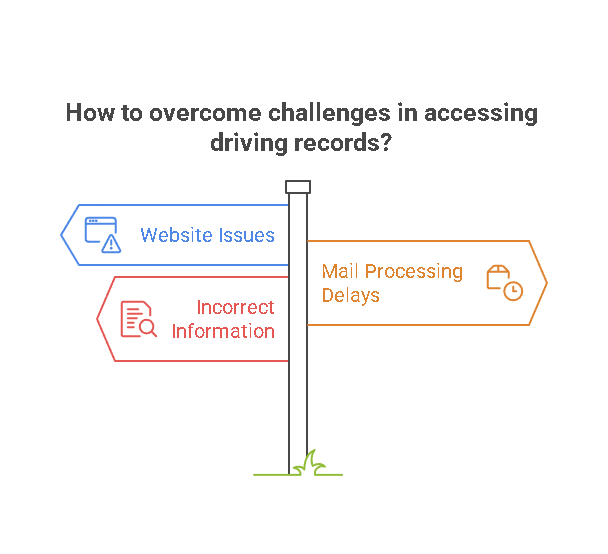
While the process of checking your driving record is generally straightforward, some individuals may encounter challenges along the way. These issues can vary depending on the method used, but here are some common ones:
- Website Issues: Sometimes, individuals may face difficulties accessing the Texas DPS website, such as technical errors or delays in processing payments. In such cases, it’s recommended to try clearing your browser’s cache, using a different device, or contacting DPS for assistance.
- Delays in Mail Processing: Requesting a driving record by mail often results in longer wait times due to mail processing and handling. Be sure to factor in the extra time needed if you choose this method.
- Incorrect Information: Occasionally, driving records may contain errors, such as missing violations or incorrect personal information. In these cases, it’s essential to reach out to the DPS or third-party service provider to get the issues corrected.
Table: Comparison of Methods to Check a Driving Record in Texas
| Method | Timeframe | Cost | Ease of Access |
|---|---|---|---|
| Online (Texas DPS) | Instant/1-3 Days | $12 (non-certified), $29 (certified) | Easy, Most Common |
| Mail Request | 7-10 Days | $10 | Moderate |
| Third-Party Service (Precisehire) | Instant/1-3 Days | Varies | Very Easy |
Legal Aspects of Driving Records in Texas
Understanding the legal framework surrounding driving records is crucial for individuals who need to check or utilize their driving history. In Texas, driving records are governed by strict privacy and access laws to ensure that personal information is protected. Below, we’ll dive into the key legal aspects of driving records in Texas, including who can access your record, how long violations remain on your record, and the implications of violations on your personal and professional life.
Who Can Access Your Driving Record?
In Texas, your driving record is private, but there are certain situations in which others may be able to access it. Access to driving records is regulated under the Texas Public Information Act, and specific rules govern who can obtain this information.
- Yourself: As a driver, you have the legal right to request and review your own driving record.
- Employers: Employers may request your driving record if you are applying for jobs that involve driving, such as delivery services, commercial driving, or any position that requires operating a vehicle. This can be done with your consent.
- Insurance Companies: When applying for car insurance or renewing your policy, the insurance company may check your driving record to determine your risk profile and adjust your premiums accordingly.
- Government Agencies: Certain government entities, such as law enforcement agencies and courts, can access your driving record when necessary for legal proceedings or investigations.
- Other Parties with Consent: You may grant permission for others to view your driving record, such as legal representatives or certain business entities conducting background checks.
It’s important to understand that unauthorized access to your driving record is illegal. Anyone attempting to obtain your record without proper consent or legal justification could face penalties.
How Long Do Violations Stay on Your Driving Record?
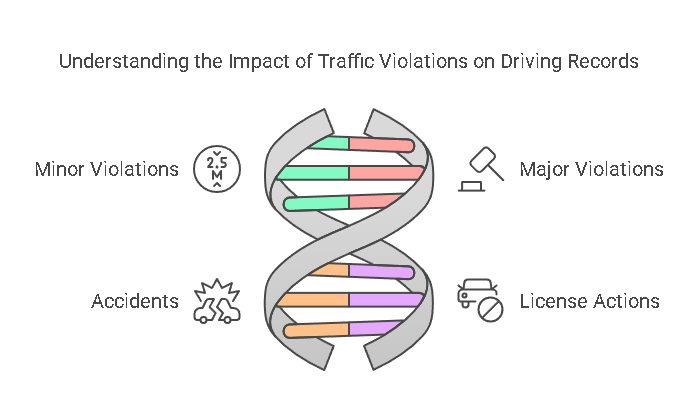
In Texas, the length of time that traffic violations stay on your driving record depends on the nature of the violation. Here’s a breakdown of common violations and how long they typically remain on your record:
- Minor Violations: Traffic violations such as speeding tickets, failure to stop at a stop sign, or running a red light usually stay on your driving record for three years from the date of the offense.
- Major Violations: Serious offenses such as driving while intoxicated (DWI), reckless driving, or accidents involving serious injury or death can remain on your driving record for up to 10 years.
- Accidents: If you were involved in a crash, the accident and any associated violations may stay on your record for three years, but the crash itself may be listed for a longer period depending on the circumstances.
- License Suspensions or Revocations: If your driver’s license was suspended or revoked, this will appear on your record for the duration of the suspension or revocation and can have long-lasting implications for your ability to drive legally.
After the relevant time period has passed, violations may no longer appear on your record, which could positively impact your insurance rates and employment opportunities. However, it’s essential to regularly monitor your driving record to ensure it remains accurate and up to date.
How Violations Affect Employment and Insurance Rates
Both traffic violations and accidents can have significant impacts on your professional and personal life, especially when it comes to employment and car insurance.
- Employment: For individuals applying for jobs that involve driving, a poor driving record can be a disqualifying factor. Employers often conduct background checks that include driving records. Violations such as DUIs, reckless driving, or a history of multiple accidents can make it difficult to find employment in fields such as transportation, delivery services, or sales that require driving.
- Insurance: Insurance companies use driving records to assess risk and determine premiums. A clean driving record often results in lower premiums, while violations and accidents can lead to higher rates. Some violations, particularly DUIs or multiple accidents, can cause insurance companies to refuse coverage altogether or offer only high-risk insurance policies.
How to Dispute Incorrect Information on Your Driving Record
Mistakes on your driving record can happen, and it’s important to dispute any incorrect information as soon as possible to prevent negative impacts on your insurance rates or job prospects. Here’s how you can go about disputing incorrect information on your Texas driving record:
- Obtain Your Driving Record: First, ensure that you obtain a copy of your driving record. You can request this online through the Texas DPS website, by mail, or through third-party services. Review the record carefully to spot any errors.
- Contact the Texas DPS: If you find an error on your driving record, you should contact the Texas DPS directly. For minor issues, such as incorrect dates or an erroneous violation, you can file a dispute with the DPS. They may request supporting documentation, such as court records or police reports, to resolve the issue.
- File a Formal Dispute: In some cases, you may need to file a formal dispute. The DPS provides instructions on how to submit a dispute, and they will guide you through the process. Be prepared to provide any necessary documentation, such as proof that the violation was dismissed or that you were not at fault in an accident.
- Follow Up: The DPS may take several weeks to resolve the dispute, so it’s essential to follow up regularly to check on the status of your case. If the DPS upholds the error, you may have to consider legal options.
- Correcting Errors through the Court: In some cases, particularly when the error involves a court ruling, you may need to work directly with the court to correct the issue. This is particularly relevant if you’ve successfully contested a violation but it still appears on your record.
Frequently Asked Questions
How Long Does It Take to Receive My Driving Record in Texas?
If you request your driving record online, it is typically available immediately or within 1-3 business days. If you choose to request it by mail, it can take 7-10 business days for the Texas DPS to process and mail your record.
Can I Check Someone Else’s Driving Record in Texas?
Yes, but only under certain conditions. You must have the written consent of the individual whose record you wish to check. Employers and insurance companies are commonly allowed to request this information as part of background checks, but personal requests without consent are prohibited by law.
How Do I Dispute Incorrect Information on My Driving Record?
To dispute incorrect information on your Texas driving record, contact the Texas DPS and submit any necessary supporting documents. The DPS will review the issue and make corrections if necessary. If the DPS does not resolve the dispute, you may need to take additional legal steps.
Can I Use a Driving Record to Get a Job in Texas?
Yes, your driving record can be used as part of the hiring process for jobs that involve driving. Employers may request your driving record as a background check to ensure that you have a clean driving history.
How Do I Clear Points from My Driving Record in Texas?
Points from traffic violations typically remain on your record for three years, depending on the nature of the offense. You can reduce points on your record by completing a defensive driving course, but this option is only available for certain violations. Completing the course may help keep points off your insurance policy as well.
Conclusion
In summary, checking your driving record in Texas is an essential task to ensure that your driving history is accurate and up-to-date. Regularly reviewing your record can help you avoid surprises, whether you’re applying for a job, renewing your insurance, or addressing any issues with violations or accidents. Whether you choose to check your record online, by mail, or through third-party services, it’s important to understand your rights and the process involved.
By keeping an eye on your driving record, you can ensure that you’re making informed decisions about your driving and maintaining a clean record. If you encounter issues or discrepancies, take action to resolve them as quickly as possible, as they can affect your personal and professional life. With the right tools and knowledge, managing your driving record in Texas becomes a straightforward and manageable process.
